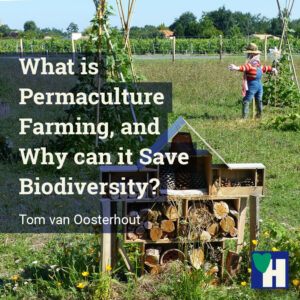
What is permaculture farming? Although permaculture is often associated with the replication of nature, design principles are at the heart of permaculture farming. It’s one of the most challenging types of farming we know.
If only because permaculture farming contrasts highly with conventional, industrial farming in which non-renewable resources are used, air, land, and water are poisoned, biodiversity is destroyed, and the soil eroded.
Sustainable and organic farming is closely related to permaculture: the continuation of all life systems is supported (the earth component), as well as community life (the people component), and a fair share for everybody (the economic component).
Some of the links are affiliate links. As an affiliate associate, we earn a commission when you purchase any of the products offered through the shared links at no extra cost for you. This helps us maintain this website.
Table of contents
The whole becomes greater than the sum of its parts
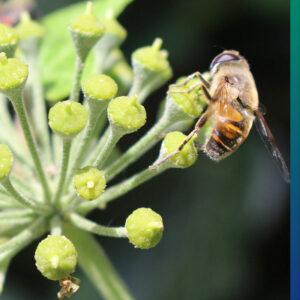
The core of permaculture’s principles is a cyclic design. The first step in this design is to observe: try to understand how nature operates. As a consequence, in practice permaculture differs from one spot to the other. Nature is nowhere the same.
The second step is to understand nature’s patterns. How do nature’s systems operate? What are the relations between the air, the water, the soil, the trees, the other plants, and the animals? When all these different components of nature seem to profit from each other, it’s time to consider how humans (could) fit in.
This is the most crucial stage in the design because the decision has to be made on how humans can profit from nature and vice versa. This stage of the cyclic design is also very complex. Most natural resources have already been tampered with by humans. If so, this requires restoration.
Related: Conventional farming versus organic farming: the unfair comparison
Restoration

Often restoration is the third step in the cyclic approach of permaculture farming: the design of an interactive program, or system, which supports a maximum yield for all-natural components involved. In which humans are also understood as a natural component.
There are some engagement principles for this stage of the cyclic design.
Maximize energy yields
To understand nature is to understand how energy is used efficiently and effectively by the integrated parts of the permaculture design. The best way to find out is by measuring yields. The higher the yields, the more energy-efficient and effective the permaculture farming design. Try to maximize energy yields. Don’t forget to incorporate human yields, not from the perspective of ourselves though: what is exactly the yield we contribute to nature?
Related: What is the best food for energy?
Recycle
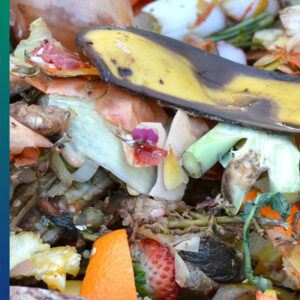
Only use renewable resources. Don’t waste anything, reuse everything. Again, we must not forget to incorporate our own waste. Including clothes and shoes and tools and the house we live in.
Unrestricted and perpetual feedback
To be able to cope with all the different mutual, multiple, and frequent impacts of the different components of permaculture farming, a system needs to be designed and used which ensures unrestricted and perpetual feedback. This feedback system is an inseparable component of the cyclic design of permaculture farming.
Cyclic changes
This is the most challenging aspect of the cyclic design of permaculture farming. We have to incorporate the changes that come with the seasons and the enormous variety in the lifespan of plants, animals, and humans. This means that we must not overdo our design ambitions. The design must always contain space for adaptation.
The people component
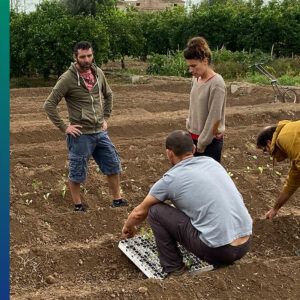
This is the fourth step in the cyclic design of permaculture farming: the design of the people component. This is a core element of what permaculture farming stands for. When you have a small garden and you are alone, there’s of course always the possibility to try permaculture farming.
However, you will have more fun, more possibilities for crop sharing, and perhaps also a better yield, when you use a large piece of land and work on it with a community of people. The advantages are obvious. A bigger piece of land offers more possibilities for a variety of plants and animals.
With a community of people, the input of various experiences and capacities improves not only the permaculture farming design but probably also enables work rotation. This way all community members learn from each other, and work rotation prevents boredom from one specific repetitive type of work.
In Spain, we know of 2 examples of communities that encourage permaculture, among other types of farming. 8 young Dutch friends bought a large piece of farmland, which was out of use, and plan to convert it into a permaculture farm. It’s exciting to see how they proceed.
We’re a member of an association that trains people to use organic seeds and farm organically. But they also train members who want to convert their land to permaculture.
Related: Citizens devoted to the conservation of biodiversity

What is permaculture farming without a fair share? The design of a fair share system is the fifth step in the design of permaculture farming. Most often we probably interpret a fair share from our personal perspective, or from the perspective of the community we operate in, and how yields are shared between community members. But what is a fair share in permaculture farming?
The fair share of permaculture farming has a far wider scope than what humans share amongst each other. Besides, it’s extremely complex. What is a fair share in a cyclic system? Perhaps the best definition of a fair share in permaculture farming is: the share in each distinct stage of the cyclic system which enables the next stage to profit from the previous one.

The unrestricted and perpetual feedback system, which is an inseparable part of the design of permaculture farming, also enables the design of a fair share system. Feedback is required from each stage of the cyclic design and system of permaculture farming.
When one stage in the cycle of permaculture farming profits from the yield of the previous stage and contributes to the next stage, the sequential yields, profits and contributions must be taken into account. This is why it is so important to calculate what the contribution is of the humans who operate within the permaculture farming cycle and profit from it.
What is permaculture farming? The highlights
The highlights of the answer to the question, what is permaculture farming, can be summarized in the following steps:
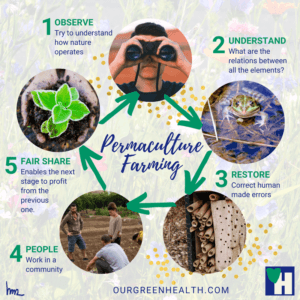
- The first step in the design is to observe. Observe that, due to the unrestricted and perpetual feedback system, observation is also unrestricted and perpetual;
- The second step in the design is to understand nature’s patterns. This is a local and integrated stage of the design. Albeit that local is limited, because all of nature’s systems are connected;
- Because through the ages humans have tampered with many natural systems, the third step in the design of permaculture farming is often the design of restoration efforts. Such efforts come with four specific cyclic engagement principles;
- The fourth step is the design of the people component. Of course, how humans fit in with the other natural components, but also how humans relate to each other. And how humans contribute to nature. What yields do humans contribute to the design?
- The fifth step is the design of a fair share system. What yields and profits fuel the cycle of permaculture farming?
What do you think of permaculture farming? Or are you familiar with permaculture farming and want to share your experiences? Please respond in the comment box.

Verry nice article
Permaculture farming very interesting so in other words using compost for fertilizer, love the concept of the whole community adding their 2 cent’s worth nowadays its hard to find communities willing to pitch in on this Permaculture farming but it would also go along with aquaponics there you’ll have control of your garbage along with another waist you could add fresh fish waist and running water that way the community could reap the rewards of the wonderful vegetables from the Permaculture farming, and the fish from the Aquaponics just something to think about.
Is there a way to control because you know there are people that deal like they need more than anyone in the community it never fails.
Thank You for this wonderfully informative article,
Bill Wright
Hi Bill,
Thank you for your comment and compliment.
Your suggestion to combine permaculture and aquaponics is very interesting. I’ve never thought about it in this way.
This combination is very promising, provided of course no chemicals are used for pest control. Only non-chemical preventive measures are applicable.
Of course, there will always be those who want more and more control. Greed and the craving for power, are almost unstoppable human traits.
Fortunately, permaculture and other alternative farming methods, incorporate strong morals and ethics of sharing and equality. Let’s hope it becomes a more widely adapted concept.
For now, stay safe, stay healthy.
Regards,
Tom
Thank you for this post! I agree with you and the vegan diet, but how to determine certain foods at what time of day for our better energy? To know exactly, we must have a schedule. For example: avocado, bananas, oranges, spinach, etc. Isn’t every bedtime food, for example? If you’re all right? Or what to eat when we get up for our better energy during the day?
Hi Zveki,
There are some rules of thumb we use combining the type of food and the time when we consume this food.
We only eat twice a day a proper meal. In the morning a light meal, I eat fruits, and Hannie eats also other varied types of light food, such as a smoothie with non-dairy milk, vegetables, and fruits, or some vegan yoghurt with nuts seeds and fruits.
Between 14:00 and 15:00 hours in the afternoon we eat a warm meal, varying every day. Only once a week we eat some fish (100-150 gr. each) or chicken/turkey (also 100-150 gr. each). We do not combine meat and rice, pasta or potatoes.
We never eat after 18:00/19:00 hours. Somewhere around 17:00 hours we usually eat a few crackers or a handful of nuts.
This schedule is okay for us. But we don’t work in construction and do not run marathons. So if you do, you might perhaps put a little bit more on your plate. But don’t vary with the times and the types of foods you mix.
Thank you for your comment.
For now, stay safe, stay healthy.
Regards,
Tom
My aunt has a small permaculture garden, and she does it perfectly. She has a small house by the river, and she only uses what’s available there to grow her garden.
There’s a lot to learn about permaculture farming, and I think more and more people should stick to it. However, it does require a lot of work, but at least you know that you’re saving nature and also that you’ll get 100% organic food from your garden.
I think that she has zero waste there. For instance, when she mows the lawn, she uses that in her garden as well.
But again, it’s great for small gardens, but I’m not so sure about larger gardens since it’s a lot of work.
Hi Petar,
You’re right, permaculture is a lot of work. Besides, you really need to know an awful lot about agriculture in general and permaculture in specific.
Friends of us recently bought a very large piece of abandoned agricultural land, they now are converting to permaculture. They are with 8 people and expect to be able to live comfortably from their land and also be able to produce for the commercial market.
The interesting thing about permaculture is of course that you need to adapt to the local situation. A desert is a totally different environment than a rainforest. And pinewoods are incomparable to pampas (South-American grasslands).
Since some 80% of the poor people on the planet (3 billion people) live in vulnerable biodiversities and practice farming, for their own subsistence and those of others, permaculture is for them a superior option. If they not already perform the permaculture principles.
Interesting subject.
Thank you for your comment.
For now, stay safe, stay healthy.
Regards,
Tom
If we as humans would do more to understand nature we would be making this planet a much better one. We should all strive to understand how nature works, what we can do to help make it better and what we should avoid doing. It’s not that difficult, we just don’t take the time to do it.
With some research we could learn so much about what plants work better with others, what flowers we should add near which plants so that they work together and so on. It can all be learned and repeated and improved. And it works.
Hi Greta,
You’re right, we lost all contact with what sustains us. Who knows all the intricacies and relations between the air, water, and the soil?
Because of this loss of contact, we have no clue what we destroy. Our historic conscience is non-existent for most people, and their historic reservoir is usually empty.
On the other hand, we’re not very much encouraged in changing things for the better. We’re more and more left on our own.
I understand that it is very difficult to join hands with others and to try and improve the world. However, the only serious options for improvement we have are the collective ones. We must organize ourselves together.
For now, stay safe, stay healthy.
Thank you for your comment.
Regards,
Tom